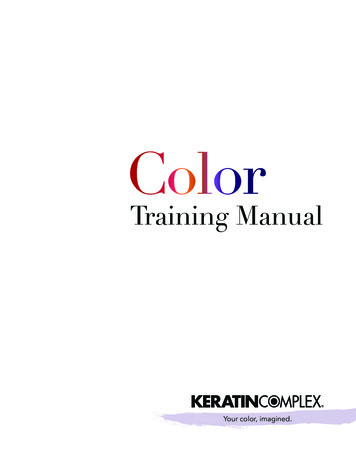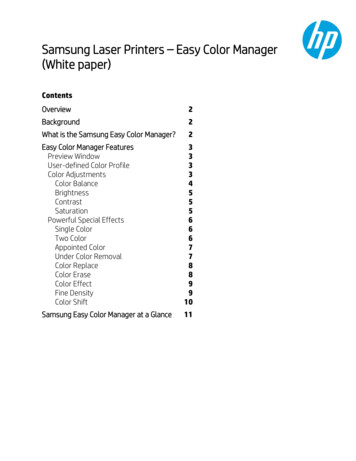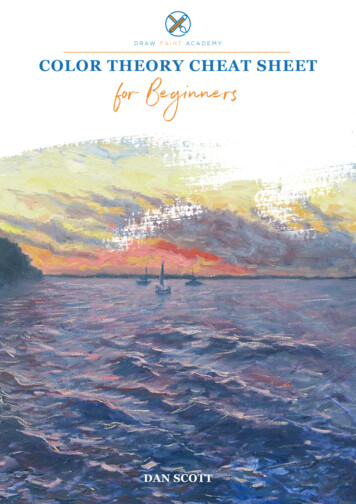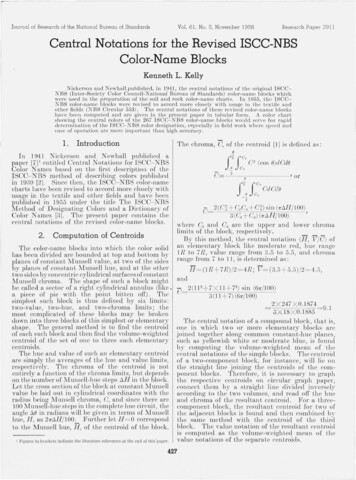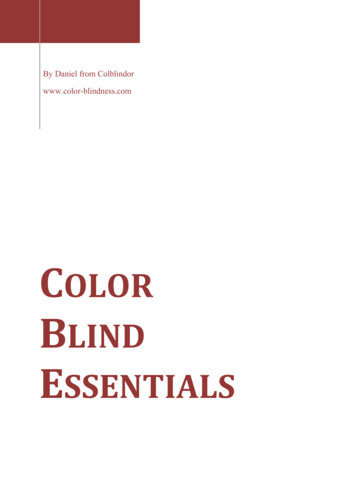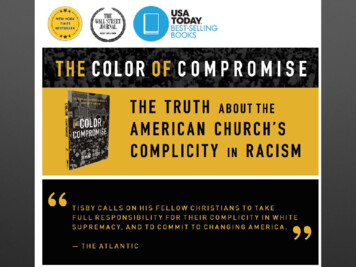
Transcription
Jemar Tisby The Color of Compromise Making Race in the Colonial Era Understanding Liberty in the Age of Revolution and Revival Institutionalizing Race in the Antebellum Era Defending Slavery at the Onset of the Civil War Reconstructing White Supremacy in the Jim Crow Era Remembering the Complicity in the North Compromising with Racism during the Civil Rights Movement Organizing the Religious Right at the end of the Twentieth Century Reconsidering Racial Reconciliation in the Age of Black Lives Matter The Fierce Urgency of Now Be Strong and Courageous
Themes: Contingency - Groups have deliberate choices and canmake other choices. “Nothing about American racismwas inevitable.” Adaptation of racism through the ages (19) Race as a social construct (22) White Moderate preferring order over justice (17) Christian complicity/compromise: silence, passivity, refusalto act in the midst of injustice, indifference to oppression,ambivalence, slave owning, participation in injustices/privileges, denial, rebuttal/resistance to “social gospel”concept. Rather than: courage, un/learning, soul work, godlygrieving/lamentation, forward looking, actively anti-racist Christian resistance/justice: Ecclesiastical splits (11)
Conversion of SlavesGod can have your soul, but we keep your body.
“Racism isn’t remarkable;what’s remarkable is that blackpeople didn’t abandon the faithaltogether. Black Christianitygrew alongside the explosiveexpansion of slavery. Their faithhelped them survive and resistslavery.”–Jemar Tisby
Don’t let fear of other people orfear of getting it wrong stop you. and more (25)The ARC ofRacial JusticeA - AwarenessR - RelationshipsC - Commitment
The Doug Section
Is “The Gospel Only” anAccession to Slavery? Question 1: Does the “Full Gospel” of Pentecostalsinclude justice as a feature? Yes, because Jesus practiced justice in the normalcourse of ministry.Question 2: Does the practice of justice count as partor all of the ministry? Preaching the Gospel and practicing justice areboth necessary parts of the ministry.
The problem of biblicalinterpretation The Bible was used as a defense of slavery. It was also used as a repudiation of slavery. So, is it true that the Bible can’t help us here?
Why the strict demand forGospel only? Slide 3: Contingency Our forbearers made choices about how to actabout slavery and segregation.Slide 4: These choices included segregation inbaptism for Slaves. The narratives for White and Blackchurches therefore diverged in purpose: The Gospel only for Whites which allowed them tofreely own slaves and a house of solace for Blacksto survive the injustice of slavery then segregation.
Tensions The now famous Parham/Seymour falling out over Parham’sracism was just the beginning of tensions around churchpolity. Estrelda Alexander’s Black Fire demonstrated that thedivide between White and Black was also present betweenMen and Women in the ministry. She deplores the erasureof women who were as active in the ministry as the men,who are often described as “the wife of Mr. John Soandso.” These examples are only two of many that mark anaccession to culture over the most generous features of theGospel.
Why did the Pentecostals/Evangelicals follow this pattern? Early Pentecostals were not culturally inept, and sosegregation as practiced in society became thepractice of the denominations emerging in the early20th century. They made decisions that further entrenched thedivide between Whites and Blacks that mainlinechurches began to abandon around the same time. The Assemblies of God promoted and practiced the“Gospel Only” pattern of slaveholders’ churches whilethe mainline churches moved toward the inclusion ofsocial justice as a full feature of the Gospel.
Kudos for the Series Tisby made clear the connections between modernchurch culture and historical precedent. He argued successfully that the church was complicitin slavery, and that culture remains today in a differentform.
Limitations of the Series Tisby acknowledges that the modern form of racism ismass incarceration. But he says nothing about the Drug War that is thesingle most important strategy for rescripting racism,white supremacy, and segregation in the UnitedStates. Lois replies that “You can’t cover everything.”Next week, I will discuss Michelle Alexander’s The NewJim Crow that centers around the inscription ofsegregation through the Drug War.
End
The Color of Compromise Making Race in the Colonial Era Understanding Liberty in the Age of Revolution and Revival Institutionalizing Race in the Antebellum Era Defending Slavery at the Onset of the Civil War Reconstructing White Supremacy in the Jim Crow Era Remembering the Complicity in the N

